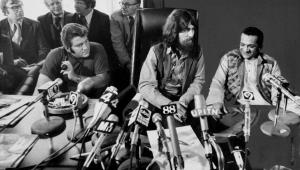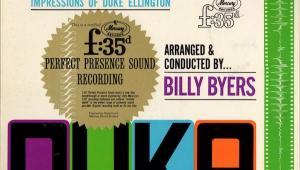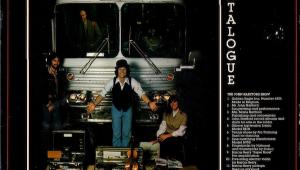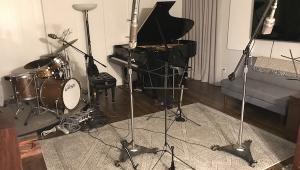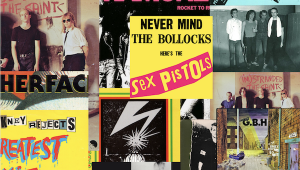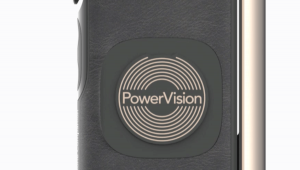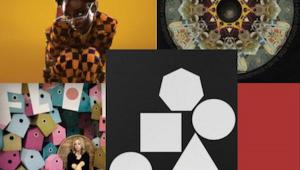Brian Wilson's Legendary Smile Album Part 1
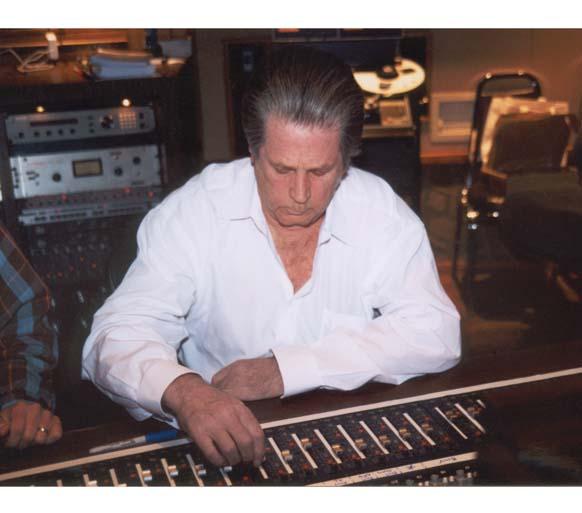
“The album became a legend. Songs and beautiful musical fragments would emerge over the years, but Smile was to have been a whole musical direction, and the individual songs, taken from their natural surroundings, were deprived of what could have been a stunning collective emotional effort. The work had started with “Good Vibrations” and it had expanded with the help of a friend (Van Dyke Parks) Brian met on Cielo Drive. Now, a year later (1967), Smile was still a dream. Too much pressure. Too many drugs. Too much anticipation. Too little support. It was the end of an era.” - Byron Preiss (“The Beach Boys”/1979)
Smile was a bunt instead of a grand-slam” - Carl Wilson
One concise paragraph and a brilliant single-sentence analogy pretty much tell you what the upshot was of pop's holiest of holy grails, The Beach Boys unreleased and unfinished 1966/7 masterpiece, Smile. For decades, it lay - not forgotten - but memorialized, analyzed and eulogized. The history of the album, in fact, has become a cottage industry, spawning countless articles, books, websites (including a 'build-your-own-Smile' site) and film/video episodes in anything having to do with the band or it's primary “conjurer”, as songwriting partner Van Dyke Parks likes to call him, Brian Wilson. It has also been said that by “killing' the album, Brian saved himself. While that may not be quite true, it was pretty close to the end of the line for the Beach Boys as a revolutionary, creative entity who rivaled The Beatles during pop's most adventurous era.
With that said, who would have even dreamed that nearly four decades later the music from the project would not be 'completed', but performed live in all of it's dazzling brilliance by it's creator and a crack ten-piece band, augmented by strings and horns? On top of that, the trilogy of material seamlessly stitched together for the concerts would also be recorded in the studio…and is slated to be released in the very near future - tentatively by years' end. This year, by the way.
All of the current activity is explained and explored by vocalist/vibes/keyboardist Darian Sahanaja in an interview to follow. One of Los Angeles' own Wondermints, who serve as the core of Wilson's live ensemble, and who are, on their own, perhaps the finest exponents of pop in the last 30 years, as their four albums' on Japan's Sony/Neosite label (among others, world wide) will easily attest. Sahanaja humbly calls himself Brian's 'musical secretary' for this project, and also served similar duties on Wilson's brilliant Pet Sounds tours. You'll soon read (and hopefully also hear) that Darian's self-appointed job description goes much, much deeper.
But before we get to the interview, Senór Fremer, your doting editor and site host, has given me my brief: to provide you with a thumbnail ( well, maybe a little more than just a 'thumbnail') of what the original Smile project was…and perhaps more importantly, wasn't.
Smile away…
“Dove nested towers, the hour was strike the street, quicksilver moon…”
It's early 1966 in Los Angeles, at the dawn of the age of Aquarius. For almost a year, The Byrds were America's very own Beatles, having defined the folk-rock genre and now in the middle of pioneering psychedelic 'raga-rock', an all-purpose moniker that they hung their newly drone-filled, harmony laced inventions on; defined by “Eight Miles High”. For a brief moment, too, their slightly less complicated yet unmistakable and equally progressive harmony clusters had even eclipsed the Beach Boys themselves. The Mamas & The Papas, Love, The Turtles and Buffalo Springfield among others were defining the new, hip musical sensibility. Yet in the middle of all of this, Brian Wilson and the Beach Boys stood the tallest. They were in the midst of their classic phase, completing Pet Sounds and almost always mentioned in the same breath as the Beatles and the Stones.
Regularly at the top of best-of pop/rock albums (usually alternating with Sgt. Peppers…), this record, a masterpiece of melancholy, quietly spoke to a generation of young people whose heads were being turned a little too quickly by the hip ethos of the day, and of course, by young romance. It was art, it was personal to Brian Wilson, but the groups' label, Capitol, didn't quite get it…not to mention some of the Beach Boys. Mike Love called it “Brian's ego music” and warned him “not to fuck with the formula.” This was a problem, and would only get worse… especially because where Brian was headed, there was no “formula”. It also didn't quite burn up the charts as fast as previous Beach Boys records, and it's top-10 showing was somehow disappointing to Capitol, so much so that they released a 'Greatest Hits' collection within a couple of months to cover their backs. This was the beginning of the lack of support.
But Brian wasn't panicking; in fact, he was truly inspired. During the album sessions, Brian came up with a brilliant and strange new song with the working title “Good, Good Vibrations”. Tony Asher, the lyricist for Pet Sounds, drafted some lyrics for possible inclusion on that album, but Brian instinctively knew that this song - this 'record' - had to be given its own time. But the seed was planted, and Brian also had his secret ingredient, the Theremin, which produced an eerie, high-pitched and spooky whine. The instrument had been used in horror and science fiction films and radio since the 1940's, and here it worked like a bandit in musically conveying 'vibrations'. Brian cut a version of the song 'live' (sans vocals), just like all of the other Pet Sounds recordings, and then set it aside.
Around this time, Wilson met a young musician/songwriter named Van Dyke Parks, at a party at producer Terry Melcher's house on Cielo Drive; later to be a famous address for other reasons. Parks, aside from being a brilliant keyboard player (he played sessions for The Byrds and Paul Revere & The Raiders and Tim Buckley among others), was a lyricist beyond the beyond. Free-association, James Joyce-ian word play and a fluid sense of history and Americana - all filtered through a brilliant mind that had clearly 'inhaled' - only begin to describe what Van Dyke could do with words. Equally as important though, and the quality that he shared with Brian - was a love of humor. To Brian, the physical and mental release of laughter was perhaps the most sublime moment of people's day to day lives. A moment when all guards are down and the true soul comes out to play, without pretension. Laughter, as a spiritual/religious experience was just one of the places Brian wanted to go with his new music.
“A diamond necklace played the pawn, hand in hand some drummed along to a handsome man and baton”
So began the songwriting collaboration, simulations with Brian cutting “Good Vibrations” (the final lyrics were co-written with Mike Love) at different studios, in sections. This style of recording was new to Brian, and is paramount to the Smile saga. Brian was recording sections of songs; a bridge here, a verse there, a fragment or chorus later, often at different studios, sometimes working on unfinished songs and writing in the studio. This recording method would be commonplace with many musicians and producers later in the decade, but in 1966 it was new. Brian was writing records: Darian Sahanaja describes it is 'modular songwriting' in the interview.
While “Good Vibrations” was being created, Parks and Wilson started writing material for the album, which had a brief working title Dumb Angel, before it morphed into Smile. The first song they wrote was “Heroes And Villains”. The synergy between the two songwriters was clear from their very first effort. While Brian played the main melody, Van Dyke, who detected a “Marty Robbins/Western feel”, reeled off the first line like he'd been thinking of it for months: “I've been in this town so long that back in the city/I've been taken for lost and gone and unknown for a long, long time…” - this was kismet. The song also included a unique 'music box/Bicycle Rider' interlude that was designed to be a sort of signature link throughout the album, popping up at several points, one being “Do You Like Worms”. The Beach Boys would eventually perform some of their most inventive, ambitious and humorous vocal acrobatics in this section.
“Heroes And Villains” had power, invention and humor all wrapped up in one glorious creation. But perhaps equally as important as those things, it clearly dealt with Americana, and was a sepia-toned, Matthew Brady-inspired snapshot of the wild-west with all of its drama, exploration and dignity. This was to set off a chain reaction of influence that would affect the whole project. Describing the different versions of the song and fragments thereof - including one almost ten minutes long - could take up an entire article in itself. The record was going to be the follow-up to “Good Vibrations”, which wasn't even finished yet. Brian had grand designs for this track, and wrestled with it throughout the entire Smile era. The fact that the recording that was eventually released as a single in July of 1967 pales in comparison to the previously-unreleased versions (that have since become available on various Beach Boys CD's in the last ten years) explains a lot about the demise of the album project.
“Surf's up, aboard a tidal wave…”
One of the most ambitious and beautiful songs the pair wrote was “Surf's Up”. Interestingly, the songs' genesis began with Dennis Wilson. While hanging out with Brian and Van Dyke one evening, he complained about the Beach Boys touring uniforms, which were still (yes, in 1966) the Kingston Trio-style candy striped shirts. Somehow, Van Dyke found a thread between this and America's involvement in the Vietnam War. Sketching the words like a painter over one of Brian's most shimmering melodic canvases ever, Parks created a setting as evocative as Norman Rockwell…combined with M.C. Escher.
Brian later attempted to explain (in “Goodbye Surfing”) some of the lyrics with lines like, 'Columnated ruins domino.' - “Empires, ideas, lives, institutions - everything has to fall, tumbling like dominos… Then there were the parties, the drinking, trying to forget the wars, the battles at sea: 'While at port a do or die.' The ships in the harbor, battling it out. A kind of Roman Empire thing. And then, hope. 'Surf's Up!…come about hard and join the once and often spring you gave.' Go back to the beach, the kids, to childhood.”
The song ended with a gorgeous couplet, “Child Is Father To Man”. This concept, which to me always mirrored Stanley's Kubrick's reincarnation sequence at the end of “2001: A Space Odyssey” (a good two years away) was something entirely new to popular music, let alone to The Beach Boys. Brian performed a solo version of the song for David Oppenheim and Leonard Bernstein's cameras for the television special “Inside Pop: The Rock Revolution”. According to Bernstein, the song was “too complex to get all of it the first time around.” A greater understatement was never made.
While all of this invention was going on, problems were always a step away from Brian. In the group, only Carl and Dennis supported Brian's vision unconditionally. Capitol was unhappy with the direction Brian was taking the music, joining the Mike Love chorus of ignorance. Brian's father Murray, while no longer managing the group, continued to be a hectoring influence in his son's life. Can you imagine this man - who thought “Fun, Fun, Fun” was an “unwholesome” song - relating to “a blind class aristocracy/back through the opera glass you see..”? No, he didn't. The group was also suing Capitol for - among other things - lack of production royalty payments to Brian. In the middle of this, The Beach Boys - and specifically Brian and David Anderle, his close friend and current business advisor - were attempting to launch their own label, Brother Records. Remember, this was almost two years before Apple records emerged. And then there were the drugs…






